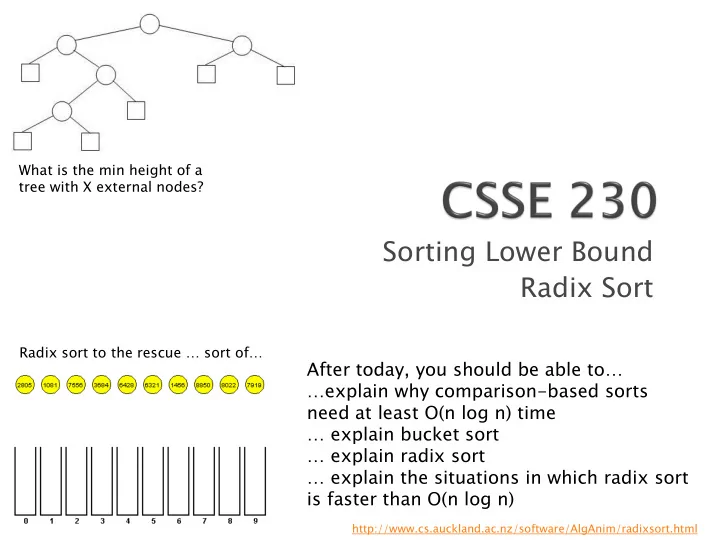

What is the min height of a tree with X external nodes? Sorting Lower Bound Radix Sort Radix sort to the rescue … sort of… After today, you should be able to … …explain why comparison-based sorts need at least O(n log n) time … explain bucket sort … explain radix sort … explain the situations in which radix sort is faster than O(n log n) http://www.cs.auckland.ac.nz/software/AlgAnim/radixsort.html
Hardy due tonight. ◦ If you are allocating an array with size that has a constant like 1.05 or +500 in it, you are violating a Hardy commandment. Read the spec again Read the linked FAQ document Talk to me about alternatives The sounds of sorting. Radix sort later. ◦ https://www.youtube.com/watch?v=kPRA0W1kECg
W e can’t do much better than what we already know how to do.
Lower bound for best case? A particular algorithm that achieves this?
Want a function f(N) such that the wo worst t case e runnin nning g time for all sorting ing algo gorithms ithms is Ω (f(N)) (N)) How do we get a handle on “all sorting algorithms”? Tricky!
We can’t list all sorting algorithms and analyze all of them ◦ Why not? But we can find a uniform orm represen presentation ation of any sorting algorithm that is based on comp mparing aring elements of the array to each other
The problem of sorting N elements is at least as hard as determining their ordering ◦ e.g., determining that a 3 < a 4 < a 1 < a 5 < a 2 ◦ sorting = determining order, then movement So any lower bound on all "order- determination" algorithms is also a lower bound on "all sorting algorithms"
Q1 Q1 Let A be any comp mparison arison-bas based ed algo gori rithm thm for sorting an array of distinct elements We can draw an EBT that corresponds to the comparisons that will be used by A to sort an array of N elements ◦ This is called a sort rt decision cision tree ee ◦ Internal nodes are comparisons ◦ Externals nodes are orderings ◦ Different algorithms will have different trees
Use Stirl rling ing's 's approx proximation mation: http://en.wikipedia.org/wiki/Stirling%27s_approximation
Q2 Q2-4 Minimum number of external nodes in a sort decision tree? (As a function of N) Is this number dependent on the algorithm? What’s the height of the shortest EBT with that many external nodes? No comparison-based sorting algorithm, known or not yet discovered, can ever do better than this!
Ω (N log N) is the best we can do if we compare items Can we sort without comparing items?
Q5 Q5 Observation: ◦ For N items, if the range of data is less than N, then we have duplicates O(N) sort: Bucket sort ◦ Works if possible values come from limited range ◦ Example: Exam grades histogram A variation: Radix sort
Q6-7 Q6 A picture is worth 10 3 words, but an animation is worth 2 10 pictures, so we will look at one. http://www.cs.auckland.ac.nz/software/AlgAnim /radixsort.html (good but blocked) https://www.youtube.com/watch?v=xuU- DS_5Z4g&src_vid=4S1L- pyQm7Y&feature=iv&annotation_id=annotation_ 133993417 (video, good basic idea, distracting zooms) http://www.cs.usfca.edu/~galles/visualization/R adixSort.html (good, uses single array)
Q8 Q8-10 10 It is O(kn) ◦ Looking back at the radix sort algorithm, what is k? Look at some extreme cases: ◦ If all integers in range 0-100 (so, many duplicates if N is large), then k = _____ ◦ If all N integers are distinct, k = ____
Used an appropriate combo of mechanical, digital, and human effort to get the job done. http://en.wikipedia.org/wiki/IBM_card_sorter
From the University of Rochester, my PhD alma mater, come Sorting Dances ! Bubble Sort: https://www.youtube.com/watch?v=WuGvUFvG7yo Merge Sort: https://www.youtube.com/watch?v=nK_o13c-0lk Shell Sort: https://www.youtube.com/watch?v=C_XggdqSLyw Should we dance on the Quad next class?
Recommend
More recommend